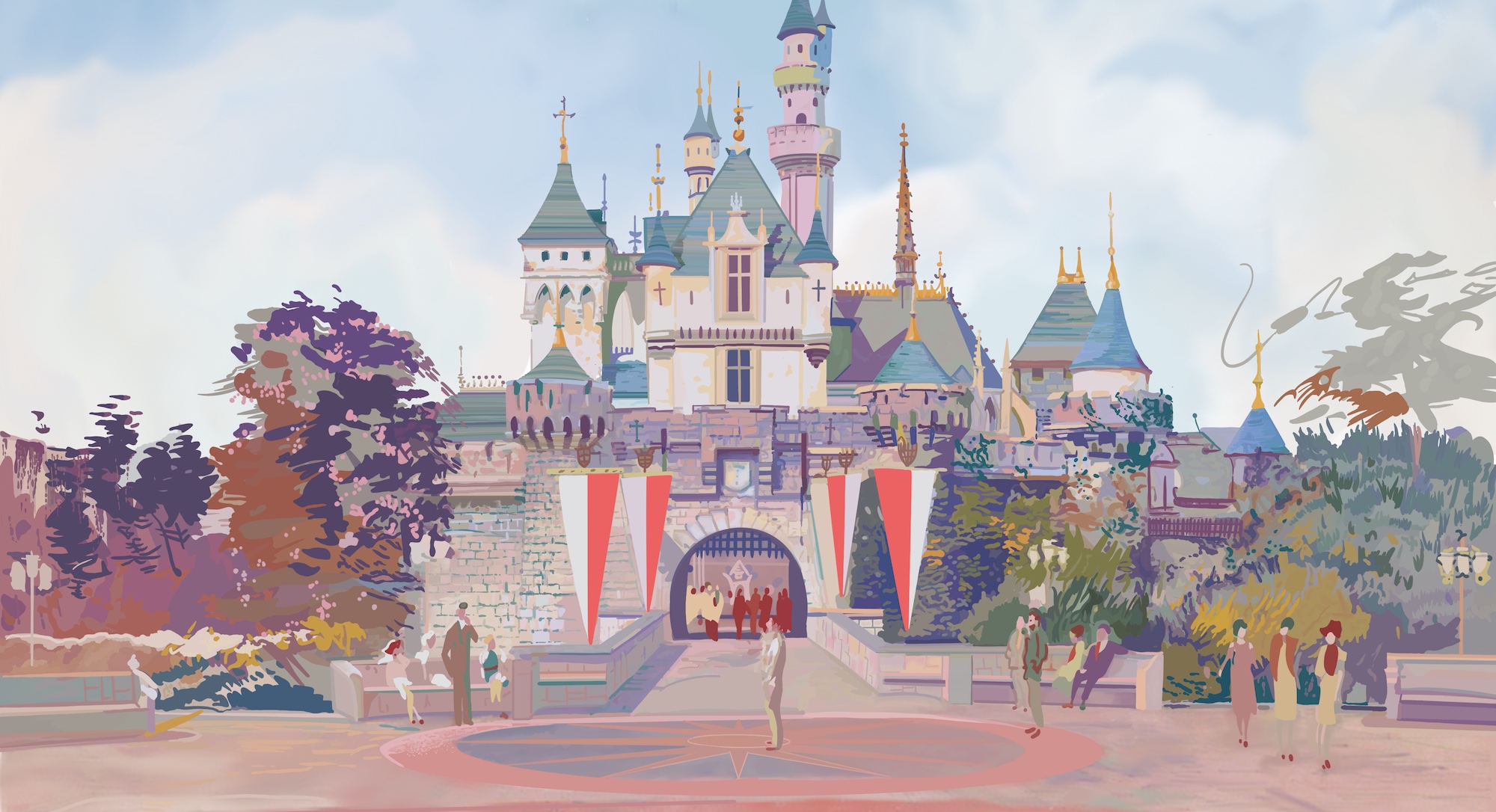13. Remy’s Ratatouille Adventure
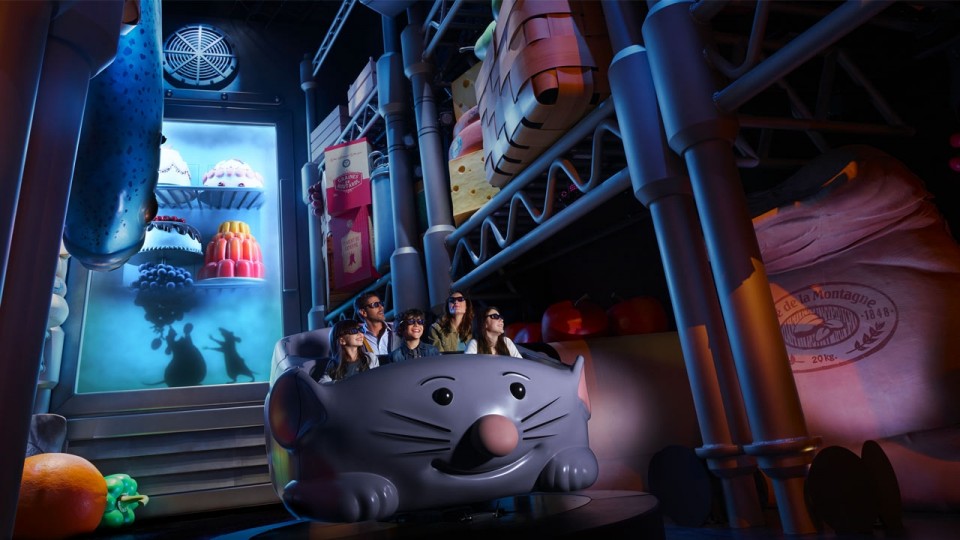
The first attraction themed to Pixar’s Ratatouille opened in 2014 at Walt Disney Studios in France. Hot on the heels of Mystic Manor, the trackless dark ride was novel, and a major headliner for such an underbuilt and underfunded park as Walt Disney Studios. Climbing aboard “ratmobiles,” guests find themselves shrunk to the size of a rat and sent scurrying through the rooftops, kitchen, and dining room of Gusteau’s restaurant.
Since guests are “miniaturized” and hiding under furniture, very large set pieces – like the giant wheels and draped tablecloth of a rolling cart, or overhead burners on a stove – help frame the scenes, but most of the action takes place on very large, domed screens. Though we included the ride in our collection of in-depth attraction histories as the Modern Marvel: Remy’s Ratatouille Adventure, it’s not without acknowledging that the ride has largely gotten mixed reviews.
It’s easy to see why. Especially at Walt Disney Studios, Remy’s Ratatouille Adventure is charming, fun, innovative, and surprising attraction featuring a technological foundation that no other Disneyland Paris ride can match. At EPCOT, though, the exact duplicate has a few notches against it:
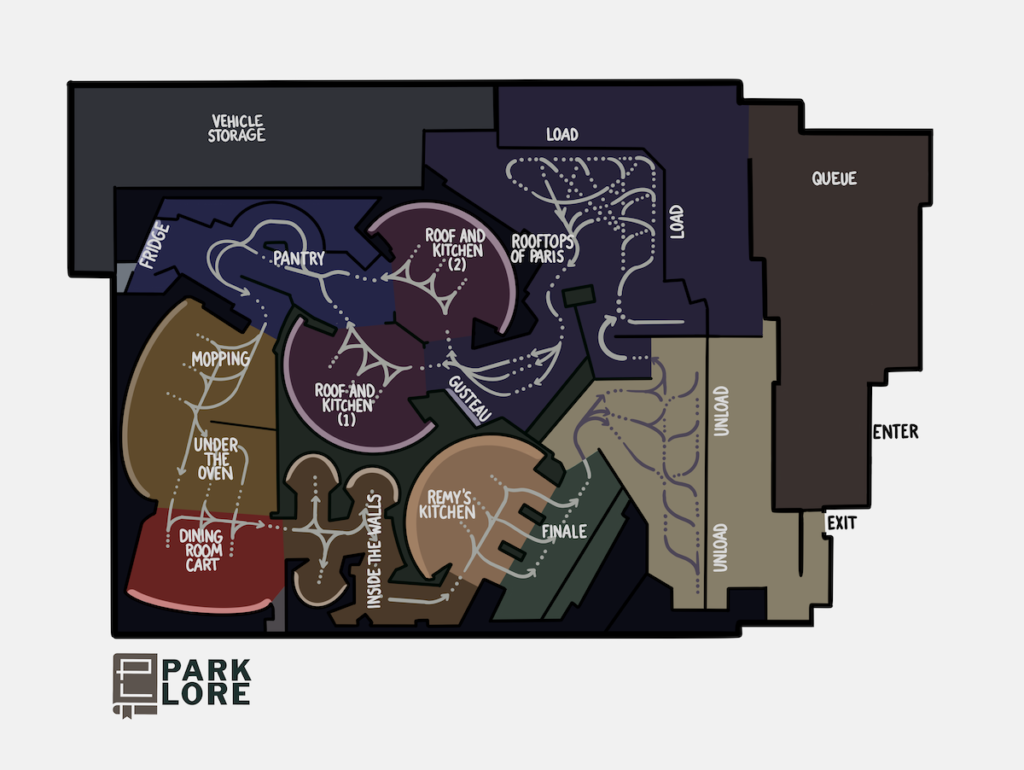
- It opened after much more show-stopping trackless dark rides like Runaway Railway and Star Wars: Rise of the Resistance;
- The mostly screen-based attraction feels like a bit of a step backwards in an industry where 3D fatigue is a real problem;
- The ride was delayed during the pandemic and artificially inflated as the single new ride to mark the launch of Walt Disney World’s deflated 50th Anniversary celebration.
…Which means that even though Remy’s Ratatouille Adventure is still just as charming and fun, it felt less so after an hour-long wait (or worse, an Individual Lightning Lane purchase). Chances are, esteem for the ride will grow as its line shrinks over the years.
In any case, the ride’s layout reveals some items of interest. For example, the first scene – which includes guests’ falling through a skylight and into a Parisian kitchen – is duplicated to allow each set of “ratmobiles” more time in it than they’d otherwise have. The clever “Inside the Walls” scene sees each “ratmobile” drive into its own domed screen for a simulated run between the baseboards. The lighting even changes as guests back out of their personal domes to suggest they really have gone somewhere.
Whether you ride it in EPCOT’s France or the real France, your experience on Remy’s Ratatouille Adventure is the same – including audio that alternates between French and English. But there is a difference between the two. At Walt Disney Studios, the unload area features windows that look into Bistrot Chez Remy – a full service restaurant that was not part of the ride’s copy-and-paste to EPCOT. EPCOT has enough restaurants.
14. Big Grizzly Mountain Runaway Mine Cars (Hong Kong Disneyland)
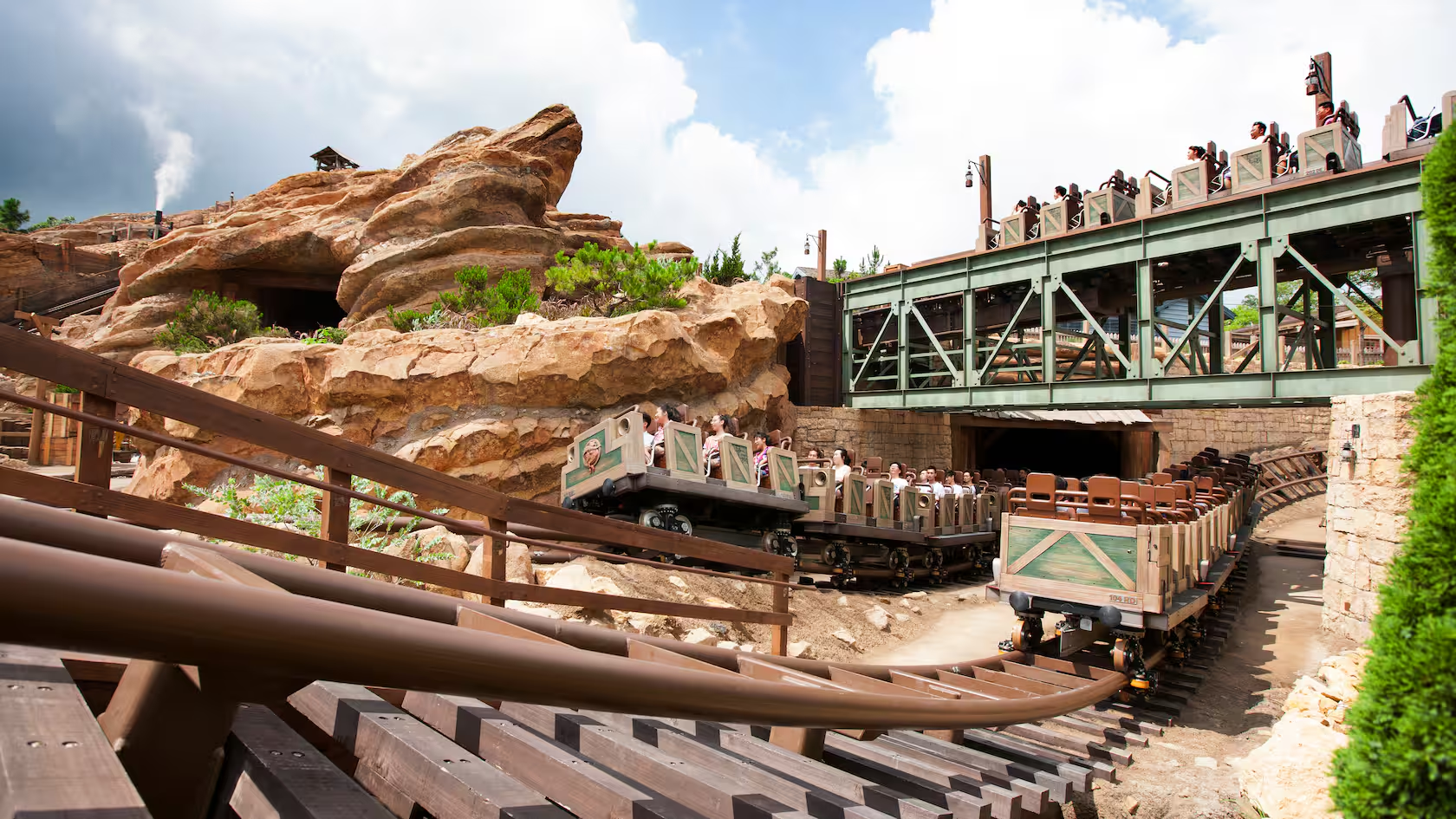
At five of the six “Castle Parks” in Disney’s portfolio, a runaway mine train roller coaster through a desert landscape serves as a formative “first big coaster” for young thrillseekers. But only Hong Kong Disneyland diverges from the tried-and-true Big Thunder Mountain in favor of something truly one-of-a-kind.
One of the underbuilt theme parks constructed at the end of Michael Eisner’s tenure, Hong Kong Disneyland was almost hilariously small. When it opened in 2005, the entire park contained just two dark rides (The Many Adventures of Winnie the Pooh and Buzz Lightyear Astro Blasters), only two rides that could even conceivably be considered headliners (Space Mountain and Jungle Cruise) and literally nothing exclusive or one-of-a-kind. A multi-year expansion constructed three mini-lands outside of the park’s berm, creating a then-unprecedented “outer loop” around the park’s equivalent of the Rivers of America. One of those three lands was Grizzly Gulch – a playful take on the American West build around a red desert rock formation that kinda sorta looks like a bear. The rusted out oasis town is practically surrounded in the chaotic criss-crossing of the totally-unique Big Grizzly Mountain Runaway Mine Cars.
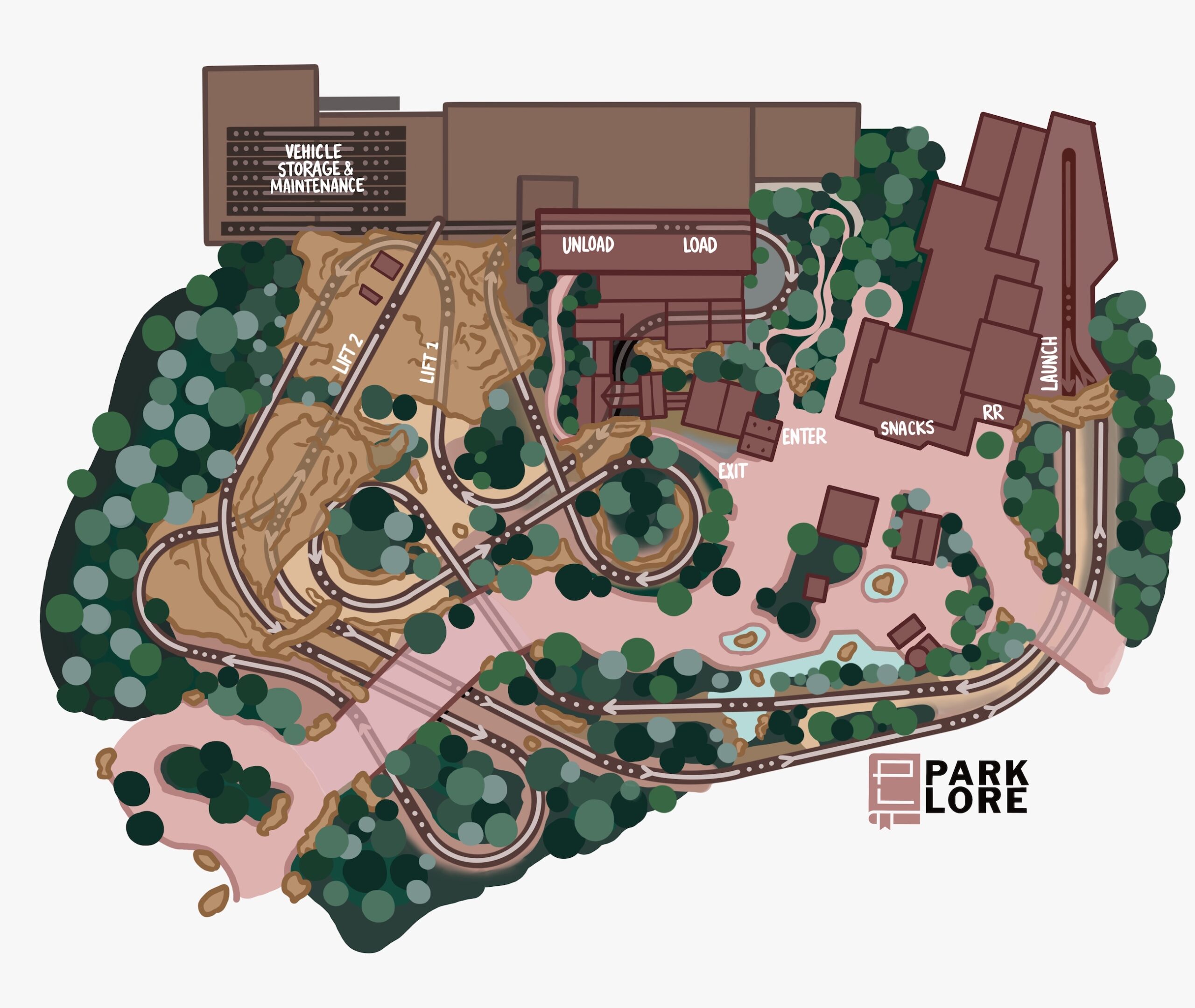
Perhaps best understood as a fusion of Big Thunder Mountain and Expedition Everest, this family roller coaster sends guests plunging through gold mines just as a curious family of bears accidentally activates track switches, dynamite explosions, and more. The ride includes forwards and backwards sections, animatronics, explosive special effects, two lift hills, and a surprise LIM launch that propels trains to 35 miles per hour – faster than Space Mountain. Terrain-hugging, track-switching, and totally custom for the park, Big Grizzly Mountain Runaway Mine Cars provides a unique glimpse into what a modern Big Thunder Mountain would look and feel like. (And yes, our dreamy Blue Sky Build-Out of Disney California Adventure includes an adapted version of the ride for that park’s very unrelated Grizzly Peak. Why not?!)
15. TOMB RAIDER: The Ride
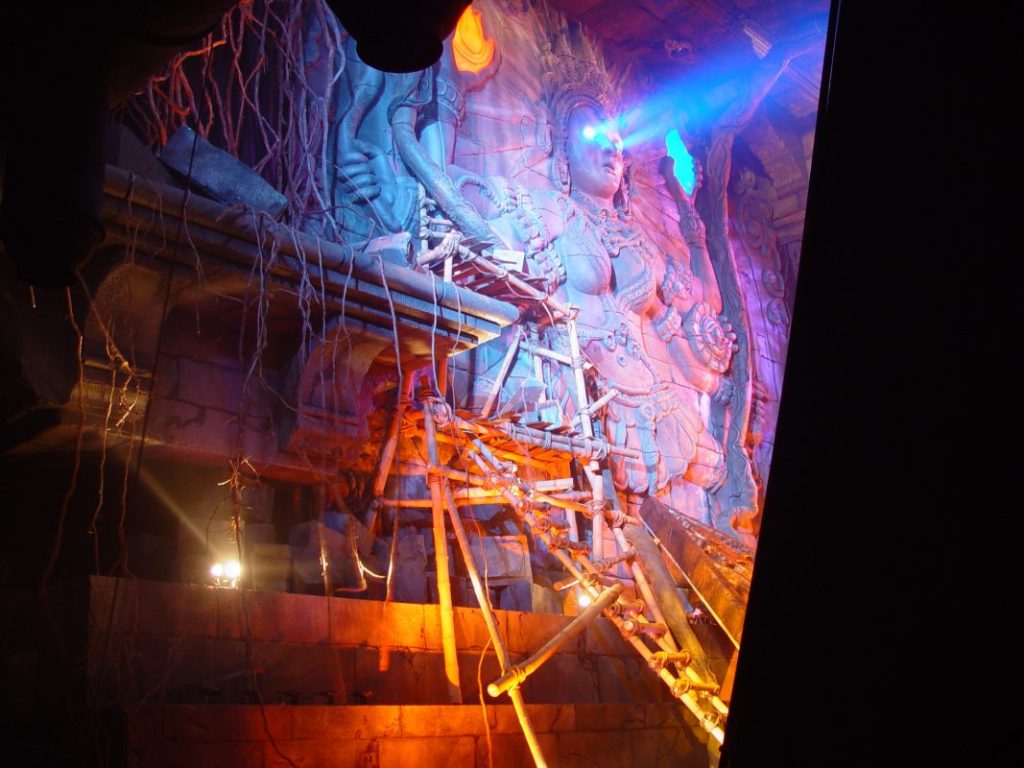
It’s very rare for regional, seasonal parks to have the kind of budget, expertise, audience, intellectual property, and chutzpah needed to build a “Disney-level” attraction or experience. Even if they’re getting better at incorporating placemaking and dark rides into their parks, Cedar Fair, Six Flags, Merlin, and other regional operators tend to ere on the side of coasters, which are easy-to-market crowd pleasers. Extravagant, highly-immersive, cinematic attractions (like the ones on this list) are generally found exclusively at Disney and Universal parks. But there are always exceptions.
In 1993, Paramount Pictures decided to dip its toes into the “studio park” era by purchasing a collection of five theme parks across North America. Under the Paramount Parks banner, Kings Island, Kings Dominion, Carowinds, Canada’s Wonderland, and Great America saw plenty of dumb, short-sighted decisions, lazy label-slapping, and thematic frustrations. But they also experienced some blockbuster highs, including an era of ambitious, themed, personality-filled, and custom coasters like The Outer Limits: Flight of Fear, The Italian Job Stunt Track, and the Lost Legends: Volcano: The Blast Coaster and Son of Beast.
Occasionally, the Paramount Parks even touched on greatness. There’s probably no better example of that than 2002’s TOMB RAIDER: The Ride at Kings Island.
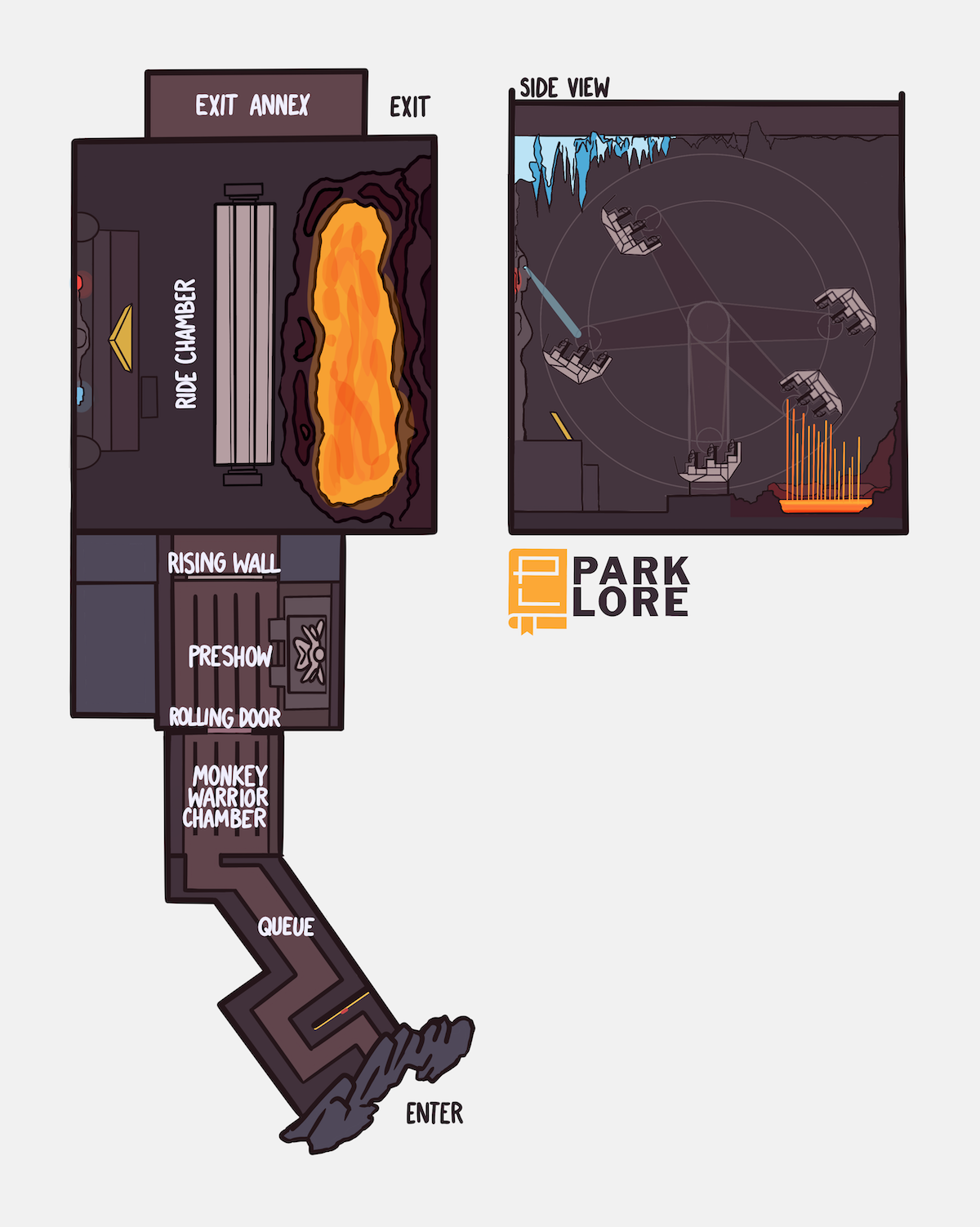
A mysterious, cinematic headliner based on 2001’s Angelina Jolie vehicle Lara Croft: Tomb Raider, the $20 million “E-Ticket” was perhaps best known for all how little was actually known about it. Entering the ruins of an ancient temple said to house the legendary Triangle of Light, guests passed through multiple pre-show experiences en route to a ride so secretive, riders still weren’t necessarily sure what it was once they were seated and strapped in.
In reality, the ride itself was a HUSS Top Spin – a flipping, free-wheeling, nauseating thrill ride you could find at most amusement parks and traveling fairs in the ’90s. But Kings Island’s model was the world’s first (and only) Giant Top Spin – a massive, 80-foot tall model seating 77 riders in three tiered rows of seats. Unlike its nimble, carnival cousins, the Giant Top Spin was like a massive, powerful moving theater that could lock its swinging gondola in position, diving, flipping, and accelerating to a synchronized musical score.
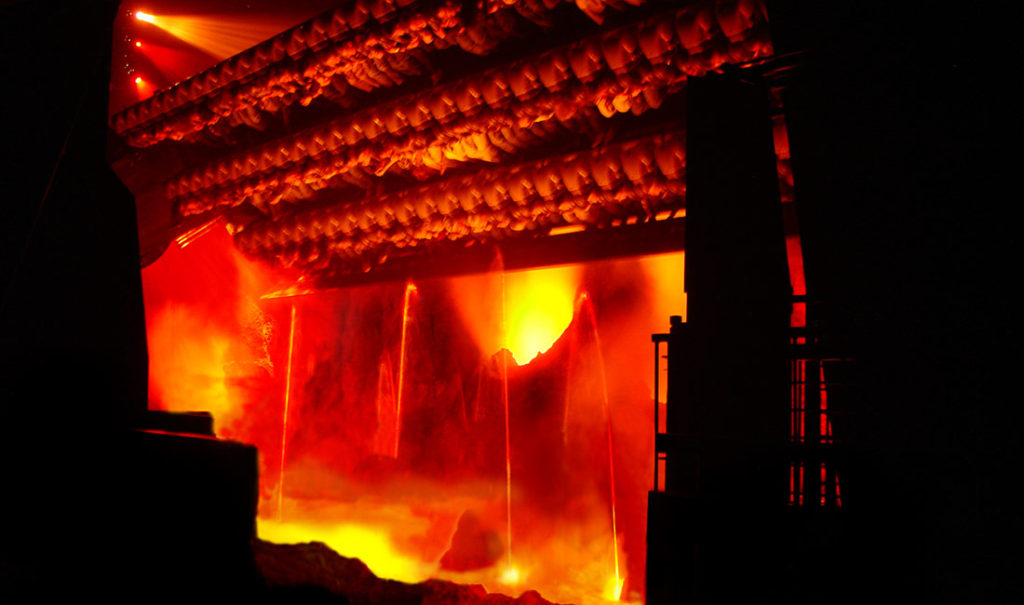
Rising to meet the eye-line of the goddess Durga, the ride would swing backwards overhead, plunging into the darkness; it would flip and lock into position, propelling guests upward to pause beneath icy stalactites, then dangle them upside down over the steaming vents of a volcano before lowering them inches from lava geysers… all synchronized to a custom, pounding, and truly iconic custom score.
In retrospect, it’s absolutely unbelievable that a seasonal, regional park in Ohio had a ride like TOMB RAIDER; an ultra-ambitious, highly-immersive, and wildly innovative thrill ride that cost more than most headlining roller coasters of the era. Of course, you won’t find TOMB RAIDER: The Ride at Kings Island today, and the world’s first Giant Top Spin was also its last. What happened? Make the jump to our Lost Legends – TOMB RAIDER: The Ride feature to dig into the details…
16. Pirates of the Caribbean: Battle for Sunken Treasure
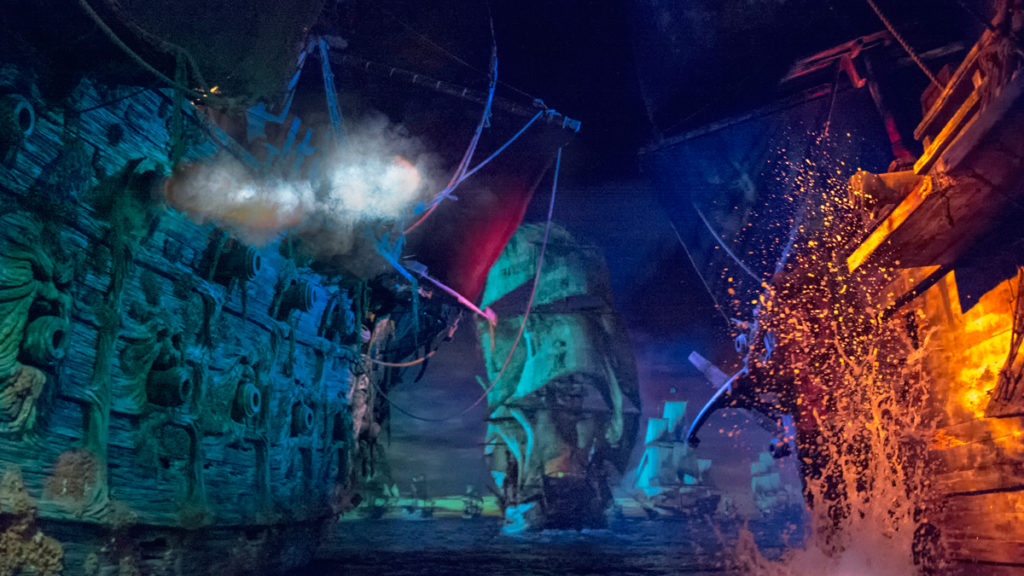
As we saw with TRON Lightcycle Power Run, Shanghai Disneyland doesn’t really have much in common with the other “Castle Parks”. The one-of-a-kind Chinese park was really a sort of reinvention of what “Disneyland” even means.
Part of that was certainly cultural, since Chinese audiences (or the park’s majority owner, the Chinese government) would have little interest in the classic “Americana” of Main Street or Frontierland or the aesthetic of the mid-century Space Race. Another part was, allegedly, contractual, with Disney promising that their endeavor on mainland China wouldn’t suffer from the same underbuilt, underfunded M.O. as Hong Kong Disneyland. Instead, Shanghai’s park purposefully omitted every “classic” Disney E-Ticket and replaced them with equally ambitious new rides that would make the park a global destination.
Pirates of the Caribbean: Battle for Sunken Treasure is doubtlessly a gem of that collection. The first Pirates ride explicitly based on the Pirates of the Caribbean film series, the ride is a multi-media adventure that includes some of the best animatronics, biggest screens, and most jaw-dropping moments in Imagineering history.
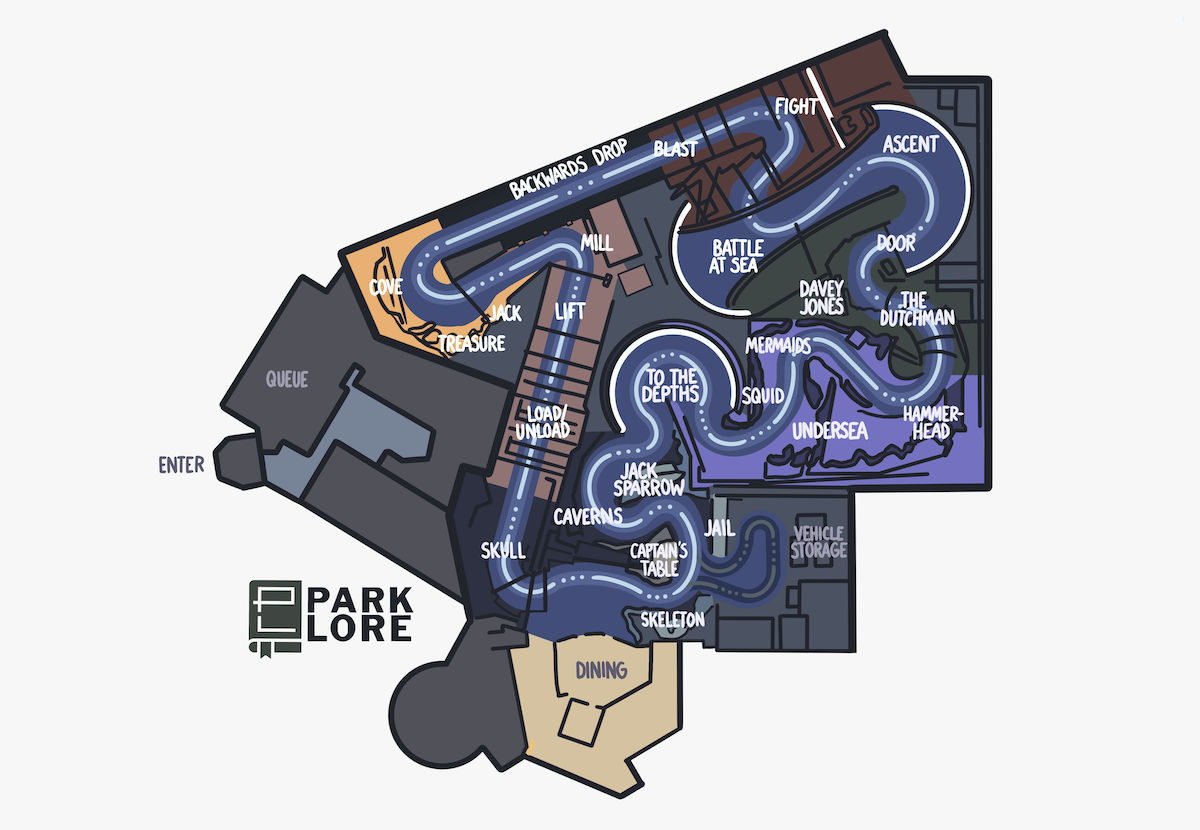
Especially when viewed in our HERE & THERE collection, it’s easy to see at even a glance that Shanghai’s Pirates is more a cousin to the original Disneyland ride, versus the sisters to it that you’ll find in Orlando, Tokyo, and Paris. In fact, the ride in Shanghai uses an entirely different ride system. Though guests do drift along water channels in boats, those vehicles are powered not by water current, but by an underwater bus bar that keeps them moving continuously through the water. Along the way, the physical track dictates each boat’s rotation, meaning that the boats can travel forwards, backwards, and even sideways through scenes.
The ride begins calmly enough – sailing past a waterside restaurant and then through caverns filled with skeletal vignettes. But the ride reveals its true potential when it enters a wraparound screen, descending underwater. The boats drift through undersea environments brought to life through physical sets and projection, then into the interior of the Davey Jones’ Flying Dutchman itself. It all culminates in the boats “rising” back to the surface in a sea battle between the Dutchman and the Black Pearl.
While it might not look like much on paper (especially compared to its multi-level cousins), Pirates of the Caribbean: Battle for Sunken Treasure is a jaw-dropping modern marvel in its own right.
17. Space Mountain: De la Terre á la Lune
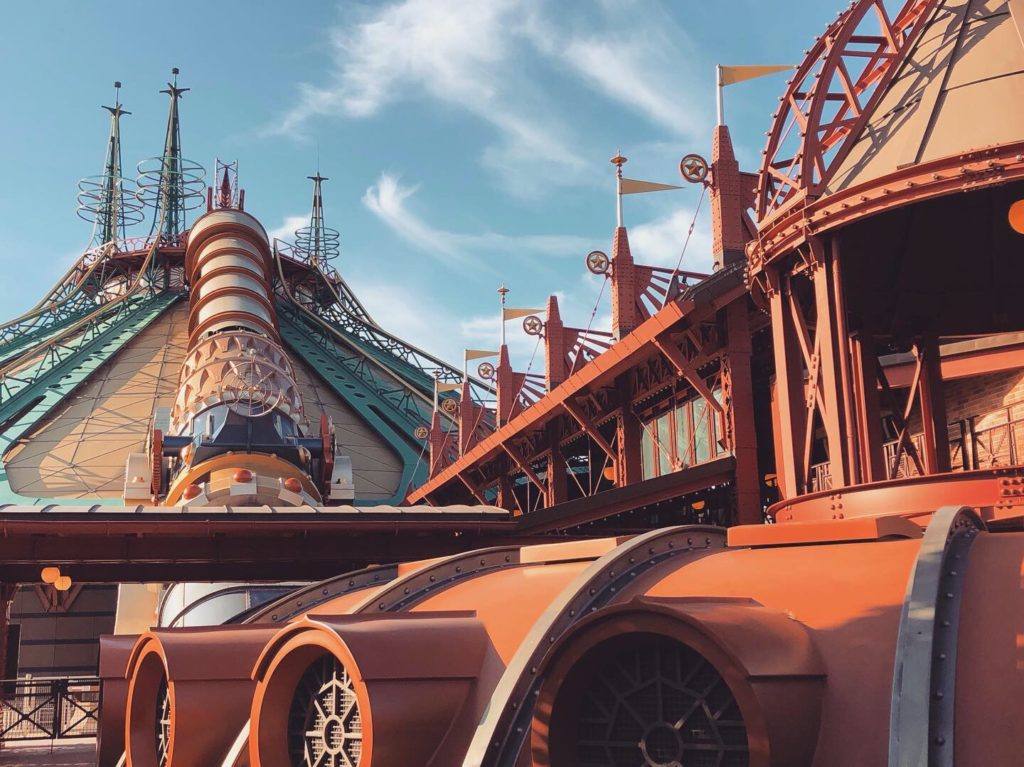
Magic Kingdom and Disneyland’s Space Mountains are significantly different rides from one another, but fundamentally, they have a lot in common. Both are fairly tame family coasters that focus on tight turns, straightaways, and unexpected dips in the dark instead of extreme maneuvers or “big drops,” and neither has much in the way of a “story,” instead opting for the sensation of sailing through the stars.
But when Disneyland Paris opened in 1992 with a golden, retro-futuristic Discoveryland drawn from European literature, plans had already been drawn up for a very different version of the peak. The never-built Discovery Mountain would’ve been a land-within-a-land, housing not just a coaster but a walkthrough, drop tower, and restaurant themed to the late 1800s fantasy adventure novels of Jules Verne.
While Disneyland Paris’ dismal financial performance upon opening doomed Discovery Mountain, in 1995, the park added its own Space Mountain – this one sculpted around Verne’s 1865 novel From the Earth to the Moon. Eschewing science for fantasy, Paris’ bronze mountain looks burst forth from a bubbling lagoon, held aloft by iron-rich red rocks. But the mountain’s most iconic feature is the golden Columbiad Cannon that rests along its copper panels, blasting riders uphill and into the mountain’s core – Disney’s first launched coaster.
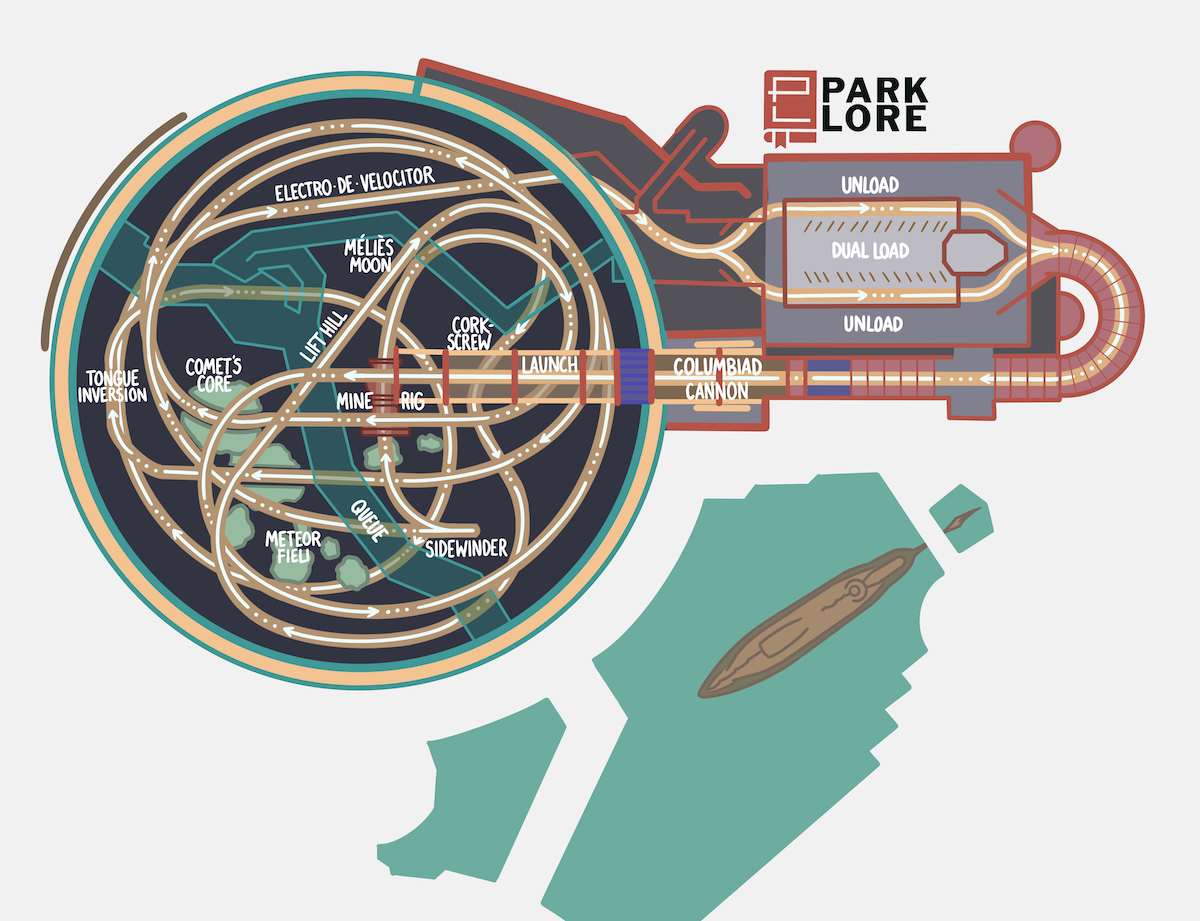
We took a ride to the moon in our Lost Legends: Space Mountain – De la Terre á la Lune feature. Back then, queuing guests actually passed through the mountain itself, gazing out into endless space as “Moontrains” corkscrewed around meteors. They then emerged into the outdoor, open-air station of the Baltimore Gun Club, departing as a triumphant orchestral score custom composed by Steve Bransom began. Loaded into the muzzle of the Columbiad Cannon, the trains were launched to top speed, then dove into the darkness of space, charging through fantasy sights and sounds and turning upside down three times. A mid-course lift hill even included allusions to French filmmaker Georges Méliè’s 1902 film adaptation, A Trip to the Moon – considered the first sci-fi film ever.
Despite being custom-built for the park, the “De la Terre á la Lune” show lasted only a decade. In 2005, the ride was “upgraded” to Space Mountain: Mission 2, which essentially meant that even though it still looked like a Jules Verne ride, the queue videos, on-ride audio, and ride interior were restyled to match every other Space Mountain, replacing fantasy with sci-fi, and bypassing the moon entirely in favor of swirling nebulae, black holes, exploding stars, and distant cosmos. “Mission 2” lasted for over a decade, too.
In 2017, the ride made another swap, becoming Star Wars Hyperspace Mountain: Rebel Mission. It wasn’t the first Space Mountain to do so (Disneyland California’s Space Mountain first used its on-board audio and projection capabilities to create a Star Wars overlay in 2015), but unlike in Anaheim, Paris’ version isn’t seasonal. It’s been the “permanent” version of the ride there since 2017. (That said, coinciding with the Star Wars overlay’s launch, the ride received all new trains that are decked out in steampunk, “De la Terre á la Lune” accoutrement, perhaps alluding to a long-range plan to #BringBackTheMoon one day…)
